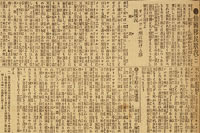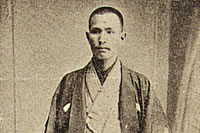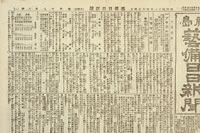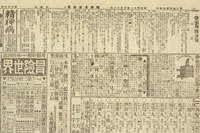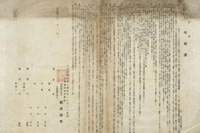First set of emigrants shipped by the Kokoku Shokumin Kaisha
Minister Fukashi Sugimura's report
When Minister Fukashi Sugimura, upon his arrival in Brazil in 1905, had an audience with the President of Brazil, and met with the Minister for Finance, they talked about problems of immigration. Sugimura felt that there were great expectations for Japanese immigration in the State of São Paulo to which he made a trip thereafter. In June of the same year, Sugimura quickly prepared a report on the trip to the State of São Paulo which detailed how promising the state was as a destination for Japanese emigration, and the report was submitted to the Ministry. Sugimura hoped that the report would be widely read in Japan and arouse interest in South America. It is said that he separately sent a part of the report by each available shipping service, because he was afraid that if he sent the whole report at one time after its completion, it could arrive later, which showed his extreme enthusiasm.
Impact of the report
The report was first published in December 1905 in the overseas trade information bulletin, "Tsusho Isan" issued by the Overseas Trade Bureau, the Ministry of Foreign Affairs, and then reprinted in the newspaper "Osaka Asahi Shimbun" at the end of the year. The report had a huge effect and there were so many requests for information from villages and towns in the provinces that the Ministry of Foreign Affairs was forced to prepare printed copies of the standardized reply stating: "Since problems on emigration to Brazil are still under investigation, the Ministry cannot offer an official response yet". After reading the newspaper article, Ryo Mizuno, executive member of the new emigration company, the Kokoku Shokumin Gaisha (Kokoku Emigration Company), immediately consulted with the Brazilian Legation in Japan and the Ministry of Foreign Affairs, and traveled to Brazil in December. (MIZUNO, Ryo. Nanbei Toko Annai) In addition to him, some people also immediately travelled to Brazil after reading the article. Among those was Saburo Kumabe, lawyer from Kagoshima Prefecture who took his family with him.
Contract with the Kokoku Shokumin Kaisha
Ryo Mizuno of the Kokoku Shokumin Kaisha (Kokoku Emigration Company) travelled to Brazil via Peru and Argentina. On board a ship along the way, Mizuno met a young man named Teijiro Suzuki, who wanted to work as a miner in a saltpeter mine in Chile but was persuaded to go together to Brazil by Mizuno. Mizuno arrived in São Paulo in April 1906 and with the aid of the Japanese Legation, Mizuno successfully made contact with leading figures in the State, but could not conclude a contract due some legal hurdles. In July, leaving Suzuki alone to gain some practical labor experience in a coffee plantation, Mizuno returned to Japan. Thereafter the law relating to immigration was amended for receiving Japanese immigrants and Mizuno visited Brazil again in the next year, in 1907 and successfully negotiated with São Paulo's Secretary of Agriculture, Carlos Botelho and on November 6, officially signed a contract with him.
The main points of the contract are summarized:
- The Kokoku Shokumin Kaisha (Kokoku Emigration Company) should recruit 3,000 people consisting of family emigrants as workers in coffee plantations and ship those people to the port of Santos in Brazil within three years. The first set of emigrants consisting of one thousand people should arrive in May 1908.
- The State Government should temporarily pay 10 pounds sterling for the shipment of emigrants, 4 pounds of which the plantation owners who would employ them should repay by making deductions from their wages.
The São Paulo State Government required family emigration because it did not need the temporary immigrants who intended to earn money and return home, but the immigrants who would stay in plantations for many years. But any of the Japanese immigrants assigned to various regions before then was single and it was actually difficult to recruit families. Mizuno negotiated with the State Government to remove the family emigration, but it did not concede. Decades later, Mizuno recollected that he had managed to have the Brazilian side to say that "the immigrants are allowed to consist of family like groups" and that he gave up with these words.
-
 Minister Fukashi Sugimura's report
Minister Fukashi Sugimura's report -
 Saburo Kumabe
Saburo Kumabe -
Articles in newspapers / magazines
-
Original materials
-
 Ryo Mizuno, pioneer attracting Japanese emigrants to Brazil
Ryo Mizuno, pioneer attracting Japanese emigrants to Brazil -
Articles in newspapers / magazines
Approval of the Ministry of Foreign Affairs
After signing the contract, Mizuno quickly returned to Japan and arrived at Yokohama in January of the next year (1908). He immediately tried to obtain permission from the Ministry of Foreign Affairs, but the clause requiring family emigration prevented the Ministry from permitting. The Ministry considered it impossible to recruit the required number of families by May and made an inquiry to the Japanese Legation in Brazil about grant of a six month extension. The reply from Minister Uchida, however, reported that since the Brazilian side was not now expected to grant the extension, the Ministry should direct each prefecture to facilitate the procedure of issuing a family relations certificate and at any rate have the emigrants set sail by May.
Recruitment of emigrants
Thus the Kokoku Shokumin Kaisha (Kokoku Emigration Company) had finally obtained the permission to recruit emigrants in February 1908. Since at that time it was virtually impossible for the emigrants to set sail in March and arrive in May, the company obtained grant of an extension until June from the State Government of São Paulo and began to recruit 1,000 people in haste. The recruitment was made by agents in each prefecture, but only 781 emigrants were recruited by the end of April (600 men and 181 women) (in addition, 12 free emigrants). There were great difficulties particularly in recruiting family emigrants, who were actually substituted with ones of "composed families" consisting of fake married couples and fake siblings.
The applicants for the recruitment had sufficient assets to borrow money for a voyage and were made up of (in descending order of the number by prefecture) 325 people from Okinawa, 172 from Kagoshima, 78 from Kumamoto, 77 from Fukushima and 42 from Hiroshima. Most of them were not farmers and included among them were police inspectors, policemen, teachers, Buddhist priests, train conductors and typographers. Incidentally, it is said that at the time Brazil was less popular emigration destination than North America and Hawaii but was more than Peru.
| Voyage preparations | Approx. 20 yen |
|---|---|
| Travelling stamp | 1 yen |
| Voyage brokerage fee | 25 yen |
| Voyage brokerage fee | 60 yen (for those 12 years old and above)* |
| Medical exams, disinfection, vaccination, etc. | 2 yen 75 sen |
| Literage and baggage transportation | Approx. 50 sen |
| Overnight hotel before embarking | Approx. 3 yen |
| Preparing and portable money | 20 yen |
| Train fare from your hometown to place of boarding | |
| Total | 132 yen 25 sen + train fare |
*30 yen (for ages 7 to 11), 15 yen (for ages 3 to 6), free (under 3 years old). The steamship fares were 160 yen (for ages 12 and above), 80 yen (for ages 7 to 11), 40 yen (for ages 3 to 6) and free (under 3 years old), the State of São Paulo, however, provided a 100 yen grant, 50 yen and 25 yen for each of these respectively. Of these grants, 40 yen, 20 yen and 10 yen were expected to be respectively repaid by coffee plantation owners later through deduction from their wages. In addition, because the State of São Paulo paid the grants after emigrants settled in coffee plantations, the Kokoku Emigration Company covered the State's portion when recruiting.

